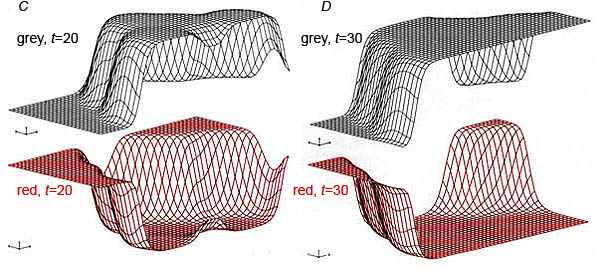 |
Competition in ecology
About 100 years ago, a small population of grey squirrels was introduced into the south of the United Kingdom and they have wiped out the indigenous red squirrel population in large parts of the UK. The exact mechanism by which this happened is controversial. We use a diffusion-competition model with parameters estimated from field data to show, by numerically solving the resultant system of coupled nonlinear ordinary differential equations, that competition alone could account for the observed displacement of the red squirrel by the grey squirrel. See publication 14 for details.
 |
 |
Two-dimensional numerical solution of the dimensionless version of the model on a 4.9 x 2.4 rectangle with zero flux boundary conditions. The initial distribution consists of reds at unit normalized density, seeded with pockets of greys density 0.1 at points (1.9, 0.4), (3.9, 0.4), (2.9, 0.9) and (2.4, 1.4). (A) Surface plot of solution at t = 5: the base density of greys is 0.0, and of reds 1.0. Solutions at subsequent times: (B) t = 10; (C) t = 20; (D) t = 30. Clearly as the system evolves the greys begin to increase in density and spread outwards while the reds recede. Eventually the greys drive out the reds. [Reproduced with permission from publication 14]
** Work carried out in collaboration with A. Okubo, M.H. Williamson and J.D. Murray